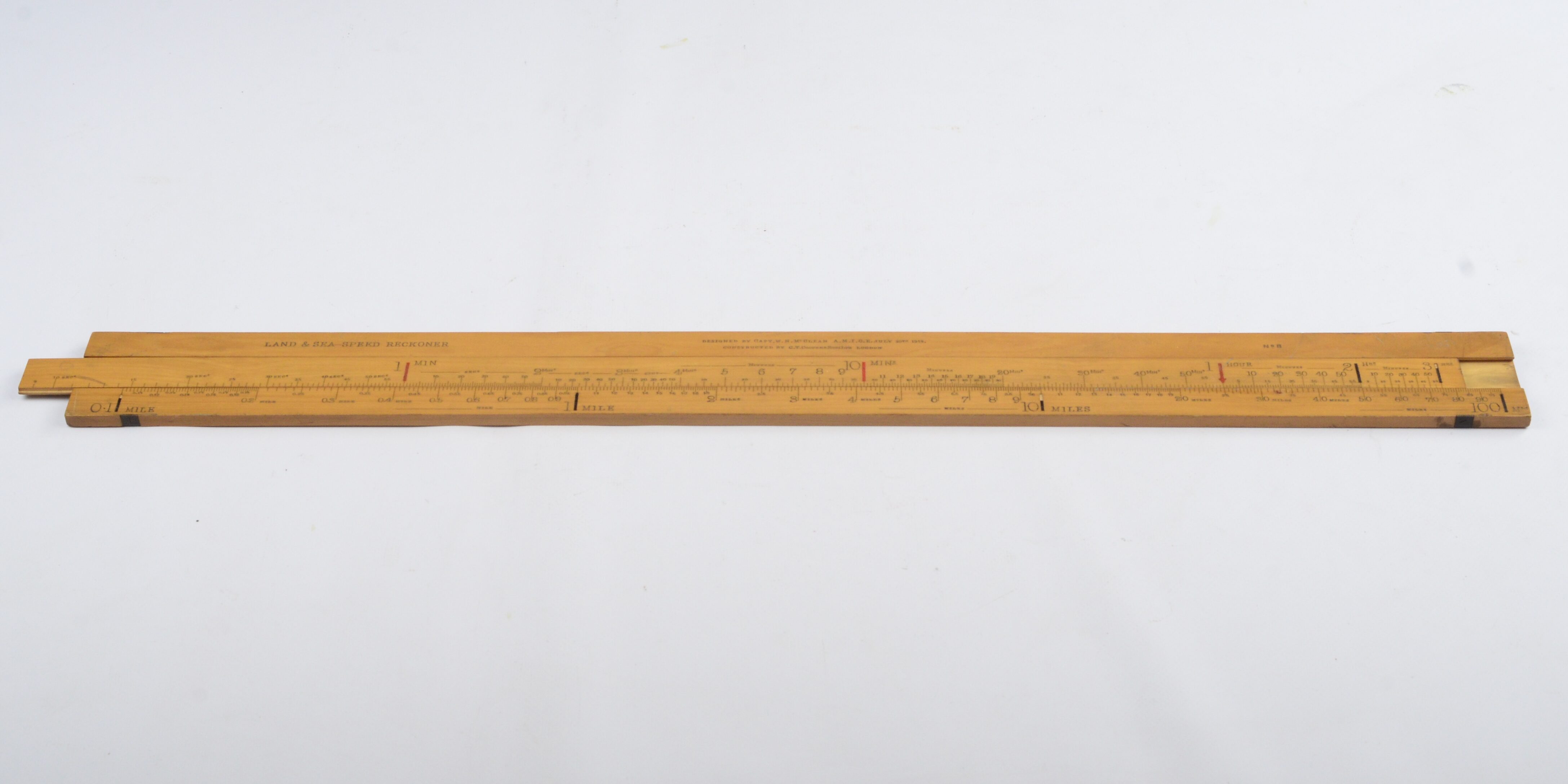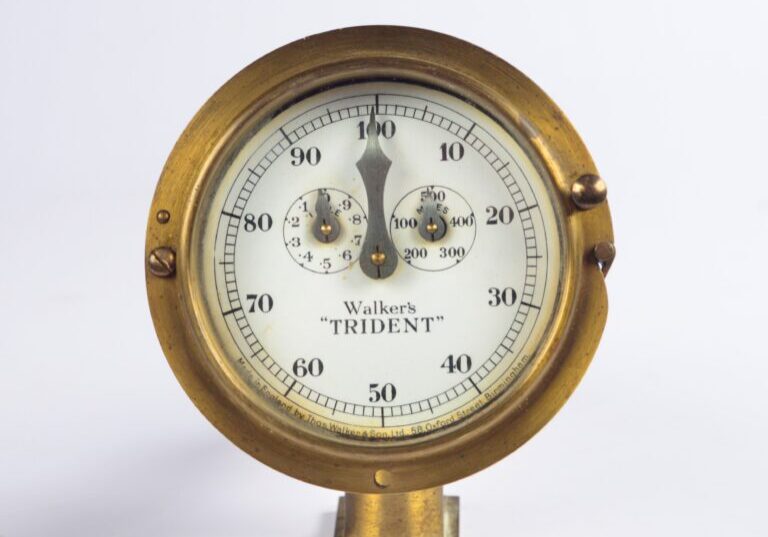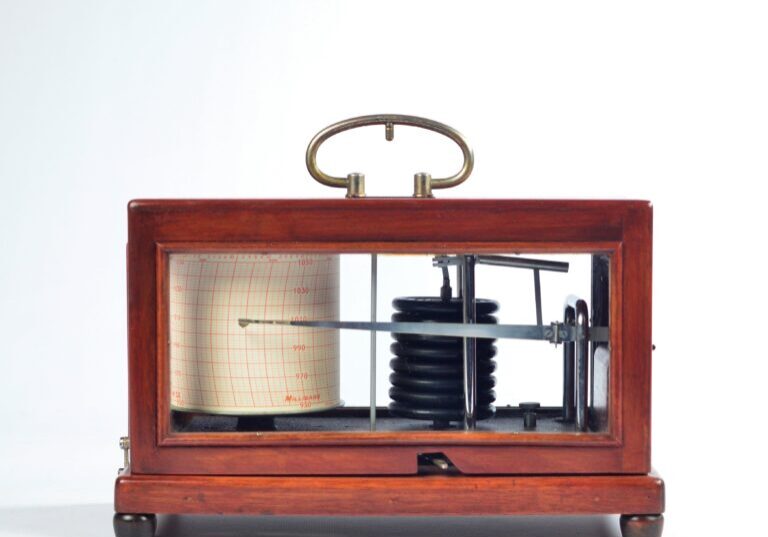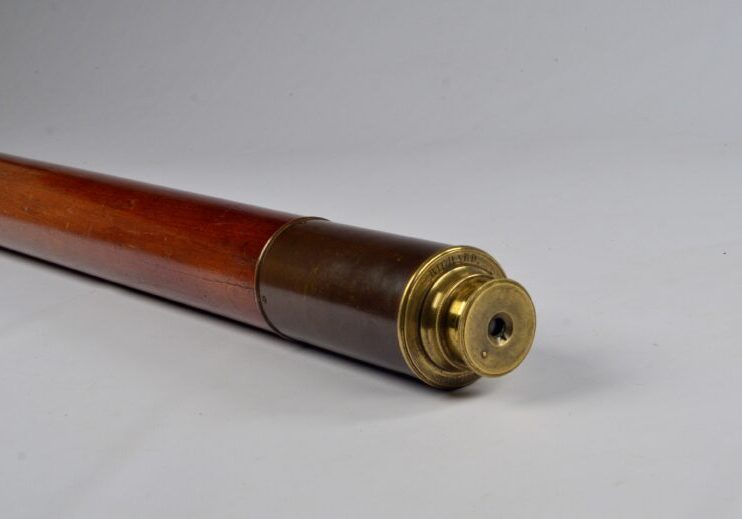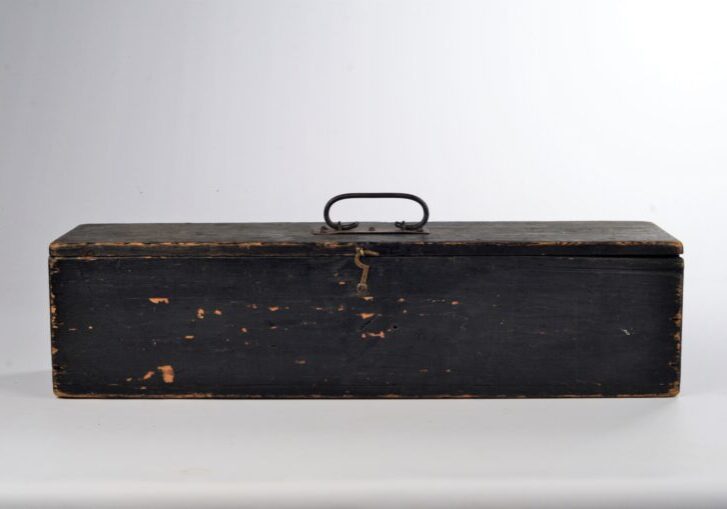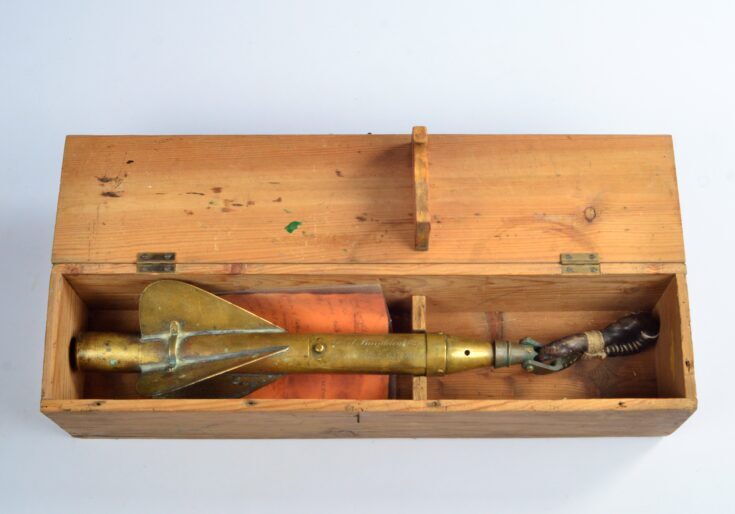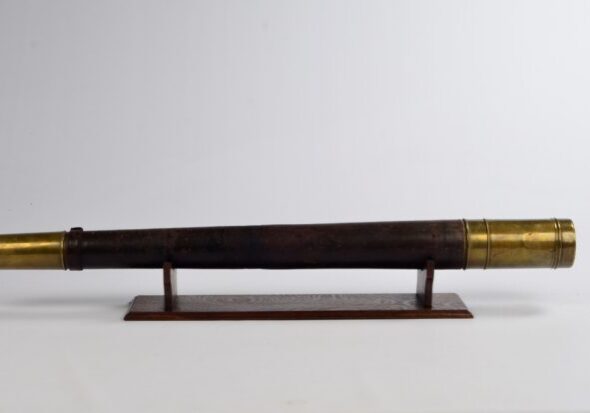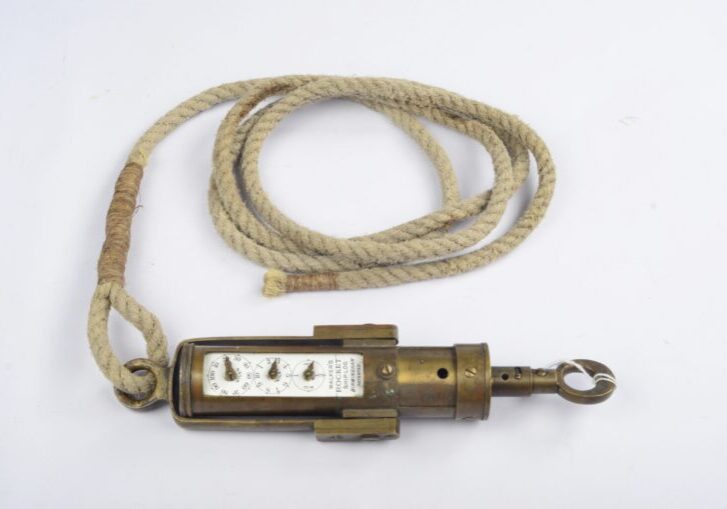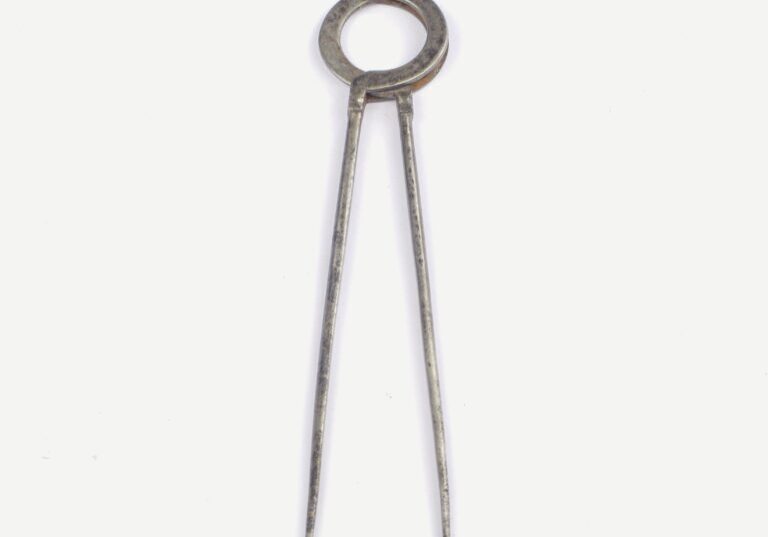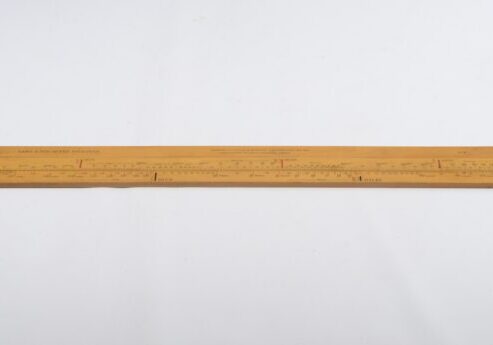Nautical instruments
This part of the collection includes mainly navigational instruments from the early sailing period, the time when ships were made of wood and men were made of steel.
A ship-log records the distance travelled through the water. With the time in hours between the observations, it gives the ship’s speed in knots.
The Trident is a large version and predecessor of the Cherub log, disigned for high speeds of 18 knots and upwards. The clock has to be fixed on the rail at the stern of a ship, the taffrail. The recorder would have been connected with a short line to the spinner and the spinner with a line of about 65 fathoms to the rotator at the end of the line. Drum and tube shape are made of brass and mounted on a gimbal foot. Serial number X2672. Makers brass plate on the body. Three dials. For use with the Cherub rotator. The original rotator with rope is missing one blade. If desired another, complete rotator can be delivered but without rope.
Thomas F. Walker (1837–1921) patented a log in 1878, the Walkers patent taffrail ship-log. It was one of the first logs in which the recorder was placed on board the ship rather than being part of the rotator. The production of the Trident commenced in 1905 and ceased around 1938. Details and serial number suggests a manufacture date around 1920.
Catalog: NM.4-28
Date: ca. 1920
LD clock: 26×13 cm (10.2×5.1 in)
LD rotor: 40×16 cm (16×6 in)
Signed: Walker’s “TRIDENT”
Origin: England
Condition: in good condition, one rotorblade missing
Rare Italian eight days barograph in mahogany case with three windows. The mecanics are made of stainless steel, with eight stage bellows. The instrument is numbered on the bottom plate and signed on top of the case. In working order and complete with key, violet ink and graphic paper. Model 715-795.
Catalog: NM.4-27
Date: ca. 1940
HWL case: 19x29x15 cm (7.5×11.5×6 in)
Signed: SIAP Bologna 7471
Origin: Italy
Very large telescope for use in lighthouses and other observation posts along the coast. It’s a single draw telescope with adjusting device. Length when closed 122 cm, pulled out 165 cm. The mainbody consists of fine quality mahogany and in good condition. The eye lens is fitted with a sliding lens protector. The objective lens has a diameter of 78 mm (3.1 in) and is provided with a brass lens cap. The barrel has taken on a nice antique patina, polished over the years.
The instrument makers, father and son Richard, had their workshop at 11 Quai St-Antoine in Lyon at least between 1831 and 1889. Later the workshop was moved to Paris.
Catalog: NM.4-22
Date: ca.1850
DL: 9×122/165 cm (3.5×48/65 in)
Signed: RICHARD. OPTICIEN À LYON
Origin: France
Condition: in good and working condition, wear consistent with age and use
From the 17th century onwards people had made many attempts to devise a mechanical log which would automatically record the ships distance done. Edward Massey invented a mechanical log in 1802 with four blades which was used by the Admiralty from 1807-1815. When dragged behind the ship the log vins rotates and the revolutions were transformed in miles on the dials, to be read after the log was brought in. The design of Massey was further refined by Thomas Walker and Son, who took out a patent for the A1 Harpoon Log in 1861. Heath & Co., instrumentmakers in London from 1845-1910, made only a few harpoonlogs based on Walkers patent of 1861, also with stabilizer.
This A2 log without stabilizer came after the A1. Rotary slide twists to reveal three dials on porcelain face. The first registers the miles up to 100, the second registers the units up to 10 mile, the third registers quarters of a mile. The four rotor blades are stamped with anchor motif and initials T.W.
The production commenced in 1863 and ceased in 1919. Mainly used in steam powered high speed vessels such as used by the Royal Navy.
Details and design features suggest manufacture date around 1880.
The original chest of pine with cautions and the Walker sticker is also complete with signs of using and painted in romantic redbrown.
Catalog: NM.3-27
Date: ca. 1880
L: 50 cm (19.7 in)
Signed: T. WALKER’S Patent HARPOON SHIP LOG A.2. London.
Origin: England
Condition: perfect with signs of use
From the 17th century onwards people had made many attempts to devise a mechanical log which would automatically record the ships distance done. Edward Massey invented a mechanical log in 1802 with four blades which was used by the Admiralty from 1807-1815. When dragged behind the ship the log vins rotates and the revolutions were transformed in miles on the dials, to be read after the log was brought in. The design of Massey was further refined by Thomas Walker and Son, who took out a patent for the A1 Harpoon Log in 1861. Heath & Co., instrumentmakers in London from 1845-1910, made only a few harpoonlogs based on Walkers patent of 1861, also with stabilizer.
On this Massey log there are three dials, the first registers miles up to 100, the second registers the units up to 10 mile, the third registyers quarters of a mile. With original rope.
The sliding cuff is inscibed with: Lord Burghley M.P. – R.V.Y.C. Ryde, Isle of Wight. The still existing Royal Victoria Yacht Club. The case is possible from a later date. In the case there is a short biography of Lord Burghley born in 1825 at Brookfield House.
Catalog: NM.2-45
Date: ca. 1810
LD: 49,5x14cm (19,5×5,6 in)
L overall: 58 cm (22.5 in)
Signed:
ROYAL NAVY
LONDON
IMPROVED LOG
LLL
Edw. Massey
Patentee
Number: 374
Origin: England
Condition: good and complete
Nice quality single draw telescope with two bras tubes and good optics in a wooden chest. The mainbody is clad with leather and has taken on a nice antique patina, polished over the years. The eye lens has a sliding lens protector. The objective lens with a diameter of 6 cm (2.5 in).
Père Edmond Lorieux had his workshop in Paris at Passage Dauphine 30 and Rue Mazarine 27 à Paris.
Catalog: NM.2-11
Date: circa 1850
L telescope: 78/93,5 cm (30.6/36.8 in)
Signed: E. Lorieux Père Paris
Origin: France
Condition: good with some general signs of wear
The stand is new made of old oak of about the same age as the telescope.
Price of the stand is E 85,=
A ship-log records the distance travelled through the water. With the time in hours between the observations it gives the ship’s speed in knots. Logs like this one are fixed on the rail at the stern of a ship, the taffrail.
From the 17th century onwards people had made many attempts to devise a mechanical log which would automatically record the ships distance done. Edward Massey invented a mechanical log in 1802 with four blades which was used by the Admiralty from 1807-1815. If the rotator was dragged behind the ship, the log rotated in the water and the revolutions were transformed in miles on the dials, to be read after the rotator was brought on deck.
Later W.F. Reynolds developed a log in which the counter was attached to the taffrail. Walker’s refined this design and patented the Rocket in 1884. The production was ceased in 1919.
The recorder, made of brass with an enamel dial, would have been connected with a line to the rotor at the end of the line. On the log there are three dials, the first registers miles up to 100, the second registers the units up to 10 mile, the third registers quarters of a mile. The rotator has an unique fixture for the log line. In 1905 the price was L 4:16:0.
Catalog: NM.3-28
Date: 1884-1919
LD: 32×4,5 cm (12.5×1.8 in)
Signed: WALKER’S “ROCKET” SHIP-LOG BIRMINGHAM (PATENTED)
Origin: England
Condition: perfect
A chart divider of wrought iron in very nice condition, striking due to its length.
Catalog: NM.4-20
Date: 1650-1700
L: 191 mm
Signed: not signed
Condition: perfect for its age, in working condition
Speed reckoner of lime wood designed by Captain McClean and made by C.T. Cooper & Sons. With this reckoner it is easy to convert an observed distance per unit of time in miles, into speed per hour.
Rare specimen in excellent condition.
Catalog: NM.4-19
Date: 1919
WL: 5,7×64,5 cm (2.2×25.3 in)
Signed: Capt. W.N. McClean A.M.I.C.E. July 30th 1919
Origin: England
Condition: perfect
